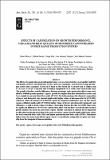Por favor, use este identificador para citar o enlazar a este item:
http://hdl.handle.net/10261/139205COMPARTIR / EXPORTAR:
 SHARE SHARE
 CORE
BASE CORE
BASE
|
|
| Visualizar otros formatos: MARC | Dublin Core | RDF | ORE | MODS | METS | DIDL | DATACITE | |

| Título: | Effects of caponization on growth performance, carcass and meat quality of mos breed capons rReared in free-range production system |
Autor: | Franco, Daniel; Pateiro, M.; Rois, D.; Vázquez, José Antonio CSIC ORCID; Lorenzo, José M. | Palabras clave: | Capons Free range Meat quality Fatty acid Weibull-growth equation |
Fecha de publicación: | 2016 | Editor: | Walter de Gruyter | Citación: | Annals of Animal Science 16(3): 909-929 (2016) | Resumen: | The effects of caponization on growth performance, carcass characteristics, meat quality and fatty acid profile of breast and drumstick of Mos and Sasso genotypes, reared in free-range production system were examined. A total of 47 birds of Mos breed (19 Castrated and 25 Entire) and 37 of Sasso X-44 (18 Castrated and 19 Entire) slaughtered at 32 weeks were used in this trial. The growth of broilers and the differences between genotypes and caponization effects were modelled by Weibull-growth equation. Capon’s growth was higher than that obtained by roosters and Sasso weight was greater than Mos results (P<0.05). For both genotypes the chemical composition of breast and drumstick cuts showed significantly higher values of intramuscular fat (P<0.0001) and lesser values of moisture (P<0.0001) in capons in comparison with intact ones. In Mos breed, capons exhibited significantly (P<0.0001) higher values of breast and drumstick luminosity and yellowness, as well as lower values of redness. Regarding Warner-Braztler test (WB), there were no significant differences (P>0.05) by caponization effect, but hardness measured using textural profile analysis was lesser in meat from capons. Finally castration of animals led to important modifications in the intramuscular fat because meat from capons showed significantly lower values for total saturated fatty acids (SFA) and higher polyunsaturated fatty acids (PUFA ). Nutritional indices were also more favorable in capon’s meat, so overall fatty acid profile of capons was desirable from the viewpoint of human nutrition | Descripción: | 21 páginas, 6 tablas, 1 figura.-- This work is licensed under the Creative Commons Attribution-NonCommercial-NoDerivatives 3.0 License | Versión del editor: | http://dx.doi.org/10.1515/aoas-2016-0009 | URI: | http://hdl.handle.net/10261/139205 | DOI: | 10.1515/aoas-2016-0009 | E-ISSN: | 2300-8733 |
| Aparece en las colecciones: | (IIM) Artículos |
Ficheros en este ítem:
| Fichero | Descripción | Tamaño | Formato | |
|---|---|---|---|---|
| Effects_Caponization_Growth_2016.pdf | 565,37 kB | Adobe PDF |  Visualizar/Abrir |
CORE Recommender
SCOPUSTM
Citations
29
checked on 16-abr-2024
WEB OF SCIENCETM
Citations
23
checked on 29-feb-2024
Page view(s)
235
checked on 18-abr-2024
Download(s)
279
checked on 18-abr-2024
Google ScholarTM
Check
Altmetric
Altmetric
Este item está licenciado bajo una Licencia Creative Commons

